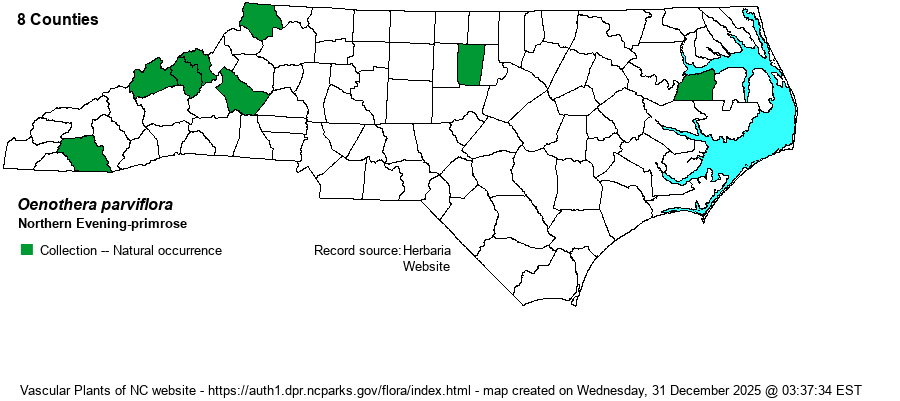| Author | L. | |
| Distribution | This is a very poorly known species in the Southeast, easily confused with O. biennis, and thus the range map below is not at all complete or truly informative. As in VA it is primarily a montane species, the range in NC is presumed to be mainly in the mountains as well. The specimen records for Orange and Washington counties might not be at natural sites.
This is a Northern species, ranging across eastern Canada and south only to the mountains of VA and into NC. Scattered records south to SC and GA must likely be of escapes or misidentifications.
| |
| Abundance | As this species is easily confused with the very common O. biennis, including specimens, the editors are not sure if this species is truly rare in NC. Because this is a common Northern species, it is assumed to be at the southern edge of the range here, but the State Rank is tentatively assigned by NCNHP as S2? and as a Watch List species. | |
| Habitat | This is a species of woodland edges, weedy clearings, thickets, and other bushy places -- preferably in sandy openings. Fine details of the habitats in NC, however, are not well described on specimen labels. | |
| Phenology | Blooms from May to October, and fruits soon after flowering. | |
| Identification | This species is the common to abundant northern "cousin" to O. biennis, though the ranges overlap. This species is very similar to it but averages shorter in stature, but the main difference is that this species has noticeably smaller flowers. Each petal is about 1/2-inch across, and thus the flower is barely 3/4-inch across, as the petals are ascending. Weakley (2018) also mentions that the inflorescence is glabrous, as opposed to conspicuously pubescent in O. biennis. The stem is also somewhat glabrous, as opposed to hairy in O. biennis. Note that the very similar O. oakesiana, a split off from O. parviflora, has the tip of the inflorescence curved, as opposed to erect in the other two species; and its leaves are dull green to gray-green, as opposed to bright green in O. parviflora and O. biennis. However, there are no definitive records of that species in NC. Check Weakley (2018) for other characters for separating these three species. You likely will have trouble identifying this species, but the most obvious field marks will be the noticeably smaller flowers, less than 1-inch across, and the smooth green parts of the plant. It probably is not overly rare in the state, owing to the scatter of county records and its disturbed habitats, which are abundant across the state. | |
| Taxonomic Comments | None, though there has always been some hesitancy in NC to consider this as a good species, or at least as present in the state at all. RAB (1968) said "Doubtfully distinct" from O. biennis.
| |
| Other Common Name(s) | Small-flowered Evening-primrose | |
| State Rank | S2? | |
| Global Rank | G5 | |
| State Status | W7 | |
| US Status | | |
| USACE-agcp | FACU link |
| USACE-emp | FACU link |

